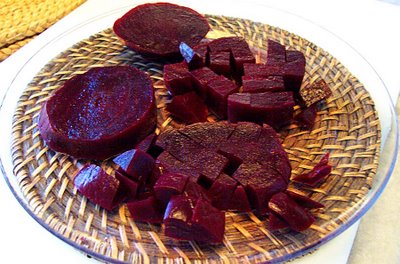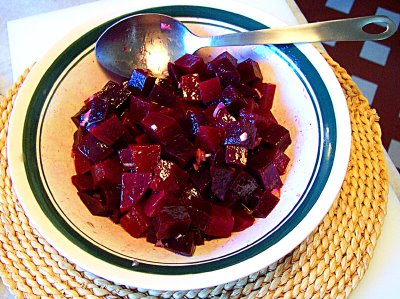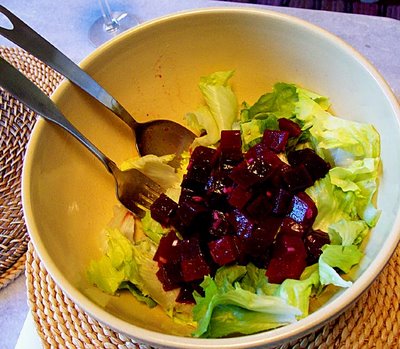Our friend Sue said she had never been able to eat them either, until she tried fresh beets rather than the ones out of a can. Maybe that's a little like mushy canned asparagus vs. the nice fresh ones. Now Sue eats beets with pleasure, she says. But cooking them is a lot of trouble, I think, or at least takes a lot of time.
I should point out that beets are called bettteraves in French, so that those who detest them can avoid ordering them. But heed my words: if there's a vegetable you think you don't like, try the French version of it when you are in France. You might change your mind. The climate, the growing methods, the serving styles, and the freshness of the vegetable in France can make an incredible difference in the taste compared to what you've had in the States.
Of course, I can't think of a vegetable I don't like. Even though I more often post recipes for and pictures of meat dishes, I never neglect the veggies or some green salad in my meal plans. In California, I worked at Apple with a woman who said she was a vegetarian. But she also pointed out that she didn't really like or eat vegetables. I think she survived on bread, pasta, and cheese. Maybe salad. She looked healthy enough and had a great sense of humor (I say that because French people stereotype vegetarians as humorless).
Walt says beets have un goût particulier — a taste all their own. He likes them, but he says they "taste like dirt." I can see what he means, but maybe it would be more appetizing to say something fancier, like "the taste of the earth they are grown in." Some wines taste like dirt... er, the earth... too, but that can also be a good taste. Terroir, you know.
The nice thing about French beets is that they are sold pre-cooked. Some are shrink-wrapped, but I avoid those. The best ones I've found around here are the ones at Intermarché, displayed in a wooden crate with a big "meat fork" you can use to serve yourself without getting red stains on your hands. You also find them cooked at the farmers' markets.
Once beets are cooked, you can just hold them under running water and rub the rough skin right off. A little trimming with a paring knife and they're ready. I like them cubed with some chopped shallot, oil, vinegar, salt, and pepper. My mother and a lot of other Americans eat them pickled, that is just with vinegar. I think that's a little sharp, myself.
 Serve some of the beets with bitter salad greens. The beets' sweetness
Serve some of the beets with bitter salad greens. The beets' sweetnesscomplements the greens perfectly — to my taste.
Beets dressed with oil and vinegar are an especially good complement (for those who can stand them) to salad greens that have some bitterness in them — escarole, curly endive (salade frisée in French), Belgian endive, arugula (roquette), or dandelion greens (pissenlits).
Ginny just gave me what sounds like a good recipe for a beet & walnut spread made with cooked beets:
Take about a pound of beets, cook them and peel them. Grind/process them with 1 cup shelled walnuts. In a small bowl, mince 1 or 2 cloves garlic. Add some salt (~½ tsp). Add 1 Tbsp oil and 2 Tbsp red wine vinegar. Mix and add to beet/walnut mixture. Add a little paprika and serve as a spread for bread, crackers, vegetables.You can also eat beets raw. Our friend Adrienne in Amboise once grated whole raw beets the way you can grate raw carrots, and then dressed them with oil and vinegar. They were delicious, I thought. Maybe people who don't like cooked beets would like them served that way.
One of the things I've always liked about standard French food is what is called une assiette de crudités. It's a plate of mostly raw vegetables (but some cooked, like beets), including grated carrots (carottes râpées), sliced cucumbers, sliced tomatoes, sliced raw mushrooms, and shredded raw green or red cabbage. The vegetables are dressed with a good mustardy vinaigrette. (Another component of such a dish, which is served as an appetizer, is shredded celery root with a mustardy mayonnaise sauce (in French, céleri rémoulade.)
I much prefer a French salad plate, where the individual items are prepared so that they are of the right texture and size, to the American tossed salad that sometimes contains big chunks of raw carrot, raw celery, raw onion, and raw green pepper. Or even to vegetable trays with raw celery stalks, raw carrot sticks, and raw bell peppers.
Maybe those kinds of rough-and-tough salads are the reason a lot of Americans call salad "rabbit food" and won't eat it. Vegetables served that way can be hard on the digestive system.
I don't think I ever enjoyed eating beets until I came to France. It's all in the presentation and dressing, I guess. But then I first came to France in 1970 and I have been enjoying things like salade de betteraves, carottes râpées, and other crudités ever since.





I can't remember a time growing up when my family didn't have a vegetable garden. A freshly pulled beet with butter is one of my favorite memories from the garden. I think you can also use beet greens in salad, but I don't remember trying them.
ReplyDeleteMy father also grew some variety of Bibb lettuce that was awesome.
I know some vegetarians with a sense of humor - I don't think vegetarians have that stereotype here.
I think I'll try German or English beets since neither country is famous for any flavor at all.
ReplyDelete(and "anonymous, above, is Tony.
ReplyDeleteMargaret and I had beets when we visited you this past fall. They were delicious. Here on the Monterey Peninsula, some chefs recommend baking them at a slow oven for a long time rather than boiling them on the stove. I love beets and the French know how yummy they are. Gabbuy
ReplyDeleteHurrah! A posting completely on beets, and I'm in it! Thanks. This reminds me of the prune thing with Ellen. Every time I see a good prune recipe, I think of you and Ellen. I love beets, too, and have several Lithuanian recipes for beets. They are great on salads.
ReplyDeleteYes, I too have always felt that beets tasted like dirt. I didn't realize I had so much company.
ReplyDeleteMarinated dirt, steamed dirt, roasted dirt, dirt smothered in butter, American dirt, French dirt - it's all the same to me.
Still, I do see one upside. If you like beets and you are ever really, really poor - well, you can eat dirt and like it!
John H.
no comparison between canned and fresh, that's for sure. I love beets, especially the golden variety. We roast them with potatoes and turnips, julienne and fry them, and love them cooked and cooled in vinaigrette. I particularly like a salad of beets and fennel in a lemon juice dressing.
ReplyDeleteThanks for sharing your great pics as always Ken.
Informative post, Ken, and good pics - but I'm not a convert yet!
ReplyDeleteMy husband likes beets even less than me and the only time he ate some was when my mom tricked him by saying it was red cabbage.
What's even more amusing - he really enjoyed them!
Evelyn, I like beet greens cooked, the same way you would cook turnip greens, etc.
ReplyDeleteChris and Tony, I am going to do a roasted root vegetable dish soon. Sounds so good, because I love turnips. Parsnips would be good if I can find some, and celery root too. If you two are going to Germany or England soon, let me know!
Gabby, I used to roast beets, wrapped in foil, in a slow oven when I was in San Francisco. I think they are better roasted than boiled.
Susan, how goes it? Borscht is a great idea for a winter meal. Back in the early 1980s I knew a French woman who had been married to a Russian (and widowed). She made a great borscht.
Ginny, beets and prunes have a lot in common, really. A lot of people don't like prunes, for example. And both beets and prunes bring a sweetness to whatever they're in but a natural, not over-powering sweetness. I love both, as you know.
John, good point. If the dollar keeps going down, we may be making and eating mud pies before long. Hey, aren't Southerners supposed to like eating dirt?
Scott, I love the fennel idea. Walt especially loves fennel, and I bet the two vegetables go together well, especially with the citrus. I'm going to try in in December.
Isabella, your husband liked the "disguised" beets, but did you?
One of my favorite salads is baby arugula, roasted red beets, bacon, feta, tossed with a balsamic vinegarette. Yummmmm.
ReplyDeleteDonna
Well, Ken, you have eliceted a lot of interesting responses to beets. And I blush beet red at being named one of the beet-haters you know.
ReplyDeleteWhat I find interesting is that I remember my father, who doesn't like a vegetable in any form (if you exclude potatoes), always liked beet borscht (from a can with generous amounts of sour cream).
Maybe I should give them a try. Then again, John told me that even if I didn't like beer I would like beer in Germany. And I didn't.
There are too many French foods that I love to waste my time on beets!
Ma chère Cheryl, à chacun son goût, n'est-ce pas ? It's just interesting to me that so many people have such a definite opinion when it comes to beets. Lima beans, broccoli, and asparagus are some other vegetables that polarize the population.
ReplyDeleteNext time you come to Saint-Aignan, let's make borscht. From fresh ingredients though. Bises...
Donna, that salad sounds fantastic. Thanks for the ideas, and happy eating.
ReplyDeleteKen,
ReplyDeletemy wife Olga is Ukrainian and they prepare an excellent relish of beets and horseradish for a traditional Easter meal "Khrin". It is made from cooked, peeled, and grated beets, grated fresh horseradish, a bit of vinegar, sugar, and salt to taste. We prefer a high concentration of horseradish as well as some fresh grated horseradish as a side relish for the rest of the traditional meal: sliced boiled eggs, bread (Paska), sausages (kilbassa) ,etc.